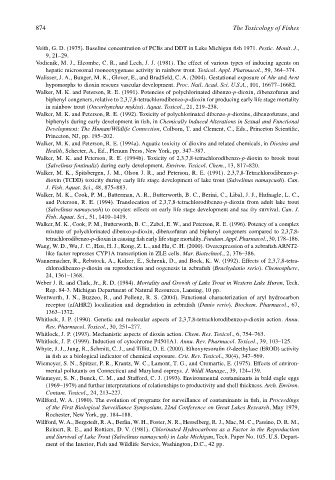Page 894 - The Toxicology of Fishes
P. 894
874 The Toxicology of Fishes
Veith, G. D. (1975). Baseline concentration of PCBs and DDT in Lake Michigan fish 1971. Pestic. Monit. J.,
9, 21–29.
Vodicnik, M. J., Elcombe, C. R., and Lech, J. J. (1981). The effect of various types of inducing agents on
hepatic microsomal monooxygenase activity in rainbow trout. Toxicol. Appl. Pharmacol., 59, 364–374.
Walisser, J. A., Bunger, M. K., Glover, E., and Bradfield, C. A. (2004). Gestational exposure of Ahr and Arnt
hypomorphs to dioxin rescues vascular development. Proc. Natl. Acad. Sci. U.S.A., 101, 16677–16682.
Walker, M. K. and Peterson, R. E. (1991). Potencies of polychlorinated dibenzo-p-dioxin, dibenzofuran and
biphenyl congeners, relative to 2,3,7,8-tetrachlorodibenzo-p-dioxin for producing early life stage mortality
in rainbow trout (Oncorhynchus mykiss). Aquat. Toxicol., 21, 219–238.
Walker, M. K. and Peterson, R. E. (1992). Toxicity of polychlorinated dibenzo-p-dioxins, dibenzofurans, and
biphenyls during early development in fish, in Chemically Induced Alterations in Sexual and Functional
Development: The Human/Wildlife Connection, Colborn, T. and Clement, C., Eds., Princeton Scientific,
Princeton, NJ, pp. 195–202.
Walker, M. K. and Peterson, R. E. (1994a). Aquatic toxicity of dioxins and related chemicals, in Dioxins and
Health, Schecter, A., Ed., Plenum Press, New York, pp. 347–387.
Walker, M. K. and Peterson, R. E. (1994b). Toxicity of 2,3,7,8-tetrachlorodibenzo-p-dioxin to brook trout
(Salvelinus fontinalis) during early development. Environ. Toxicol. Chem., 13, 817–820.
Walker, M. K., Spitsbergen, J. M., Olson J. R., and Peterson, R. E. (1991). 2,3,7,8-Tetrachlorodibenzo-p-
dioxin (TCDD) toxicity during early life stage development of lake trout (Salvelinus namaycush). Can.
J. Fish. Aquat. Sci., 48, 875–883.
Walker, M. K., Cook, P. M., Batterman, A. R., Butterworth, B. C., Berini, C., Libal, J. J., Hufnagle, L. C.,
and Peterson, R. E. (1994). Translocation of 2,3,7,8-tetrachlorodibenzo-p-dioxin from adult lake trout
(Salvelinus namaycush) to oocytes: effects on early life stage development and sac fry survival. Can. J.
Fish. Aquat. Sci., 51, 1410–1419.
Walker, M. K., Cook, P. M., Butterworth, B. C., Zabel, E. W., and Peterson, R. E. (1996). Potency of a complex
mixture of polychlorinated dibenzo-p-dioxin, dibenzofuran and biphenyl congeners compared to 2,3,7,8-
tetrachlorodibenzo-p-dioxin in causing fish early life stage mortality. Fundam. Appl. Pharmacol., 30, 178–186.
Wang, W. D., Wu, J. C., Hsu, H. J., Kong, Z. L., and Hu, C. H. (2000). Overexpression of a zebrafish ARNT2-
like factor represses CYP1A transcription in ZLE cells. Mar. Biotechnol., 2, 376–386.
Wannemacher, R., Rebstock, A., Kulzer, E., Schrenk, D., and Bock, K. W. (1992). Effects of 2,3,7,8-tetra-
chlorodibenzo-p-dioxin on reproduction and oogenesis in zebrafish (Brachydanio rerio). Chemosphere,
24, 1361–1368.
Weber J. R. and Clark, Jr., R. D. (1984). Mortality and Growth of Lake Trout in Western Lake Huron, Tech.
Rep. 84-3. Michigan Department of Natural Resources, Lansing, 10 pp.
Wentworth, J. N., Buzzeo, R., and Pollenz, R. S. (2004). Functional characterization of aryl hydrocarbon
receptor (zfAHR2) localization and degradation in zebrafish (Danio rerio). Biochem. Pharmacol., 67,
1363–1372.
Whitlock, J. P. (1990). Genetic and molecular aspects of 2,3,7,8-tetrachlorodibenzo-p-dioxin action. Annu.
Rev. Pharmacol. Toxicol., 30, 251–277.
Whitlock, J. P. (1993). Mechanistic aspects of dioxin action. Chem. Res. Toxicol., 6, 754–763.
Whitlock, J. P. (1999). Induction of cytochrome P4501A1. Annu. Rev. Pharmacol. Toxicol., 39, 103–125.
Whyte, J. J., Jung, R., Schmitt, C. J., and Tillitt, D. E. (2000). Ethoxyresorufin O-deethylase (EROD) activity
in fish as a biological indicator of chemical exposure. Crit. Rev. Toxicol., 30(4), 347–569.
Wiemeyer, S. N., Spitzer, P. R., Krantz, W. C., Lamont, T. G., and Cromartie, E. (1975). Effects of environ-
mental pollutants on Connecticut and Maryland ospreys. J. Wildl Manage., 39, 124–139.
Wiemeyer, S. N., Bunck, C. M., and Stafford, C. J. (1993). Environmental contaminants in bald eagle eggs
(1969–1979) and further interpretations of relationships to productivity and shell thickness. Arch. Environ.
Contam. Toxicol., 24, 213–227.
Willford, W. A. (1980). The evolution of programs for surveillance of contaminants in fish, in Proceedings
of the First Biological Surveillance Symposium, 22nd Conference on Great Lakes Research, May 1979,
Rochester, New York, pp. 184–188.
Willford, W. A., Bergstedt, R. A., Berlin, W. H., Foster, N. R., Hesselberg, R. J., Mac, M. C., Passino, D. R. M.,
Reinert, R. E., and Rottiers, D. V. (1981). Chlorinated Hydrocarbons as a Factor in the Reproduction
and Survival of Lake Trout (Salvelinus namaycush) in Lake Michigan, Tech. Paper No. 105. U.S. Depart-
ment of the Interior, Fish and Wildlife Service, Washington, D.C., 42 pp.

